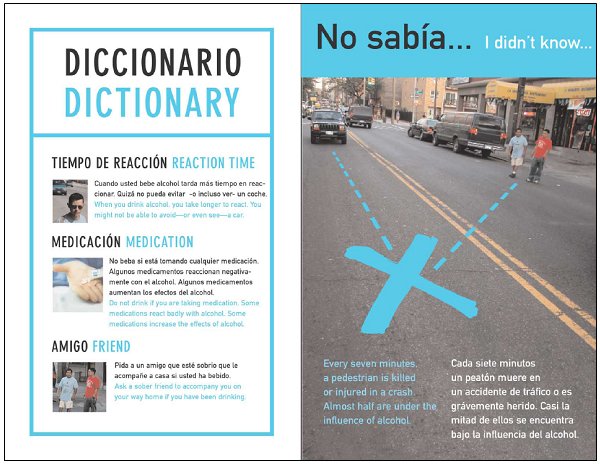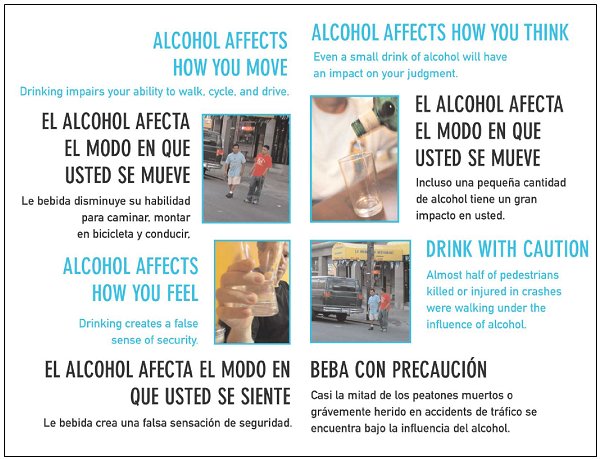U.S. Department of Transportation
Federal Highway Administration
1200 New Jersey Avenue, SE
Washington, DC 20590
202-366-4000
| < Previous | Table of Content | Next > |
The project team developed two radio PSAs (entirely in Spanish – the scripts include English translations), one text PSA (in Spanish, with an English translation), five bilingual brochures, and five bilingual flyers.
Radio PSA #1 features two Mexican-American men talking, and one attempts to cross the street to speak with a woman. Since the red hand is displayed on the pedestrian signal, he is nearly hit by a car. The sounds of a horn honking and brakes squealing can clearly be heard. The premise is that the first man must have been "in a hurry to die" by demonstrating this behavior. At the end of the PSA, a voiceover states (in Spanish), "Every seven minutes, a pedestrian is killed in the United States. Too many Latinos are among them. Look both ways before you cross the street and respect the traffic lights. Teach/show those you love."
In radio PSA #2, two Mexican-American women are walking. The younger woman is a recent immigrant, while the older has lived in the U.S. for a while. The younger comments on the speed of traffic. The older says, "You'll get used to it." The sound of cars almost crashing is heard and then the older says that she'll never get used to the traffic at that corner. She then says, sadly, that her oldest son was killed while crossing the street at that corner. "He probably thought that the driver would stop. You cannot think like that here. You must always look both ways before crossing...before it's too late." The voiceover is similar to that of the first radio PSA: "Every seven minutes, a pedestrian is killed in the United States. Too many Latinos are among them. Be aware of the signals and cross carefully. Teach/show those you love."
In a text version of PSA #3, two Mexican-American men are talking. One is late for work and rushes across the street (while the red hand is displayed on the pedestrian signal) to try to catch the bus. He is nearly hit by a car. The second man tells the first, "...I don't know who's going to take care of your wife and kids after you've been hit by a car. Even if you survive, you're not going to be working for a long time." The ending is the same as in the first radio PSA.
The brochures and flyers address five topics:
For each topic, the brochure and flyer have both similar format and content. Both the brochure and flyer are double-sided. The brochures and flyers for each topic have the same general layout. As an example, the draft alcohol brochure is shown in Figures C-1 and C-2.
On the front side (Figure C-1), the large photo on the right depicts two young Hispanic males crossing the street diagonally, a car approaching on the far side, dotted lines representing the paths of the pedestrians and the driver, and a large "X" showing where a crash could occur. The title reads "No sabía" / "I didn't know..." and a bilingual fact is printed over the photo. The brochures are folded such that the large photo, title, and fact are on the cover.
The left side is a bilingual "dictionary," with two or three concepts, each with an explanation and a photo. The Spanish content is in a black typeface, and the English content is in a blue typeface.

Figure C-1. Front Side of Draft Brochure on Alcohol
On the reverse side (Figure C-2) are four messages with explanations (all bilingual) and four photos. The Spanish content is in a black typeface, and the English content is in a blue typeface.

Figure C-2. Reverse Side of Draft Brochure on Alcohol
| < Previous | Table of Content | Next > |
